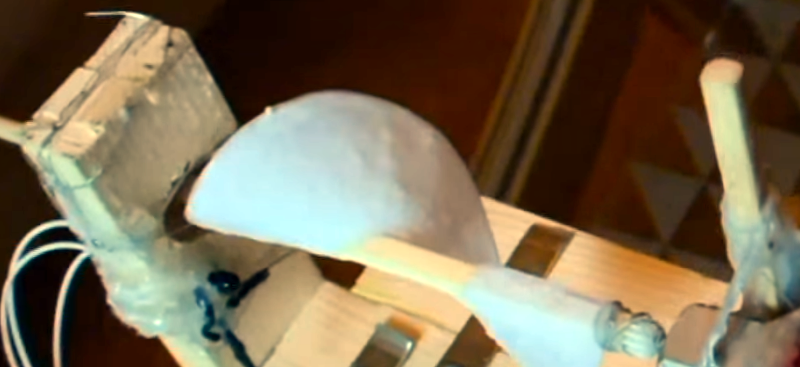If you watch much science fiction, you know that in the future, there’re plenty of 3D holographic displays. From Princess Leah’s distress call to the Star Trek holodeck, there’s no shortage of computers that can make realistic images. It might not be up to holodeck standards, but [freedscript] created a 3D display for an Arduino using a chopstick, a motor, some paper, and a LASER. Of course, it isn’t actually a hologram, but neither is half the stuff you see on TV (Star Trek’s holographic characters were disturbingly solid for standing waves). The display is a type of volumetric display.
The idea is deceptively simple. A paper corkscrew spins and a laser spot perpendicular parallel to the axis of rotation can create a point that appears to be anywhere in a slice of the volume enclosed by the outer perimeter of the corkscrew. You can see in the video below that the device is simple to build, although the results are not overwhelming. If the corkscrew is too big, the edges will have to move too fast. Also, you need a lot of LASERS, including one to sense the index point of the corkscrew.
Still, it is impressive to see an Arduino driving a 3D display, and the system is simple enough to hack if you’d like to experiment. We’ve looked at other optios for 3D displays before, both using lasers and using computer projectors. Maybe Princess Leia’s distress call will soon be a reality.
















This is basically a multi-source screw mirror mechanical TV. With a zero dimensional source you get a 2D image, with a one dimensional one a 3D image.
The laser is parallel to the axis of rotation, not perpendicular, at least as far as I can see.
Technically is more of a helix or screw, not corkscrew.
Can’t open a bottle of wine with that, but you can show with it how it’s done.
Cheers.
You have one of the best user names here …
Ah yes, the old “mirror screw”. For those who don’t know here is an interesting article on them: http://www.televisionexperimenters.com/mirscrws.html
no mirrors here, I think. This is ‘just’ a helical volumetric display. Mirror screws work by reflecting light to a screen, kind of like a laser printer.
P.s. according to early press on ST:TNG, the holodeck also used micro force fields to simulate solid as well as slippery surfaces.
who is princess leah?
A common misspelling of Princess Peach
Oops.
Not a big Star Wars fan, are you Al? :-)
I have to confess I’m a dyed-in-the-wool Star Trek fan. So to me, Star Wars is just another movie. I’ve watched them, of course, and I enjoy them, but I’m not a giant fan. A good friend of mine (Steve W) is a big Star Wars fan so we have spirited conversations on the relative merits, Enterprise vs Death Star, etc.
And I’m fans of all three. Star Trek, then Star Wars, and Doctor Who. Her name is spelled Leia. Your spellchecker grokked at that, and goofed by suggesting a proper name that’s extremely rare.
Pull the hexagonal mirror motor out of a laser printer and you can up the resolution by orders of magnitude.
The UK has the NBTVA. where you can find a lot of info on mechanical Televisions and scanning.. From Nipkow disks to spinning mirror drums.
http://www.nbtv.wyenet.co.uk/
Yeah mechanical scan/flying spot TVs are interesting. “John Logie Baird, 1st Image”. Via Wikipedia – https://en.wikipedia.org/wiki/File:John_Logie_Baird,_1st_Image.jpg#/media/File:John_Logie_Baird,_1st_Image.jpg
You should try to run the code in Java on your Arduino. It’s probably fast enough then.
Er, does it do images, or just random dots?